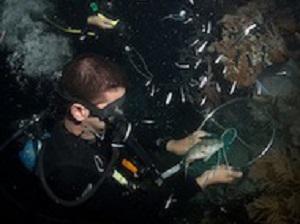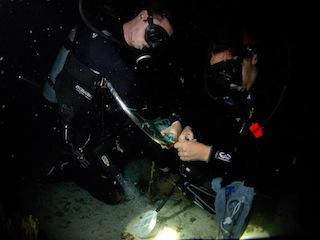Courtney E Cox
Other projects
16 Jul 2010
Effectiveness of New Belizean Fisheries Regulations on Restoring Grazer Populations and Coral Reef Resilience
25 Jun 2015
Evaluating and Improving Coral Reef Conservation Strategies across the Mesoamerican Coral Reef
The aim is to better understand herbivorous fish population management and connectivity, this study will assess the genetic structure of Stoplight parrotfish (Sparisoma viride) populations throughout the Mesoamerican Barrier Reef.

Team capturing parrotfish.
Degraded coral reef ecosystems are often characterized by low coral cover and high macroalgal cover. A primary cause of macroalgal increase on Caribbean reefs is thought to be the loss of herbivores including the regional die off of the black sea urchin (Diadema antillarum) and overexploitation of herbivorous fishes. After over 30 years, D. antillarum populations have yet to functionally recover on most Caribbean reefs which has left herbivorous fishes such as parrotfishes and surgeon fishes as the key grazers. One of the many consequences of high macroalgal cover is decreased coral recruitment. The reduction in recruitment in turn is thought to reduce the ability of coral populations to recover from natural and anthropogenic disturbances. Based on evidence that herbivorous fishes can control macroalgal abundance potentially leading to restored coral assemblages, the Belize government passed a law prohibiting the harvesting of parrotfish and surgeonfish to end their overexploitation.

Team collecting fin clip.
The success of this strategy is largely dependent on the connectivity of these species across the Mesoamerican Barrier Reef. Populations can be connected through dispersal of pelagic larvae on ocean currents. However, connectivity can be reduced by geographical boundaries, larval behaviour, or larval mortality. Ocean currents potentially link northern and southern fish populations in Belize and Mexico. However, there is some potential for larval retention in the southern Belize–Honduras region due to a surface gyre between Honduras and Belize. If herbivorous fish populations are connected throughout the Mesoamerican Barrier Reef and herbivorous fish harvesting is reduced in Belize but continues in Mexico and Honduras, the ban may have little effect on herbivore abundance and macroalgal overgrowth in Belize. Parrotfish recovery is needed to restore coral reef health that has declined due to macroalgal overgrowth. Effective management needed for the recovery of this resource requires a thorough understanding of ecological processes including larval dispersal and connectivity. Population genetics has been widely used to make inferences about larval dispersal. This project will assess the population genetic structure of Stoplight Parrotfish across the Mesoamerican Barrier Reef to evaluate connectivity of herbivorous fish. Project findings will improve our understanding of the connectivity between parrotfish populations and our ability to manage and restore Caribbean coral reef ecosystems.